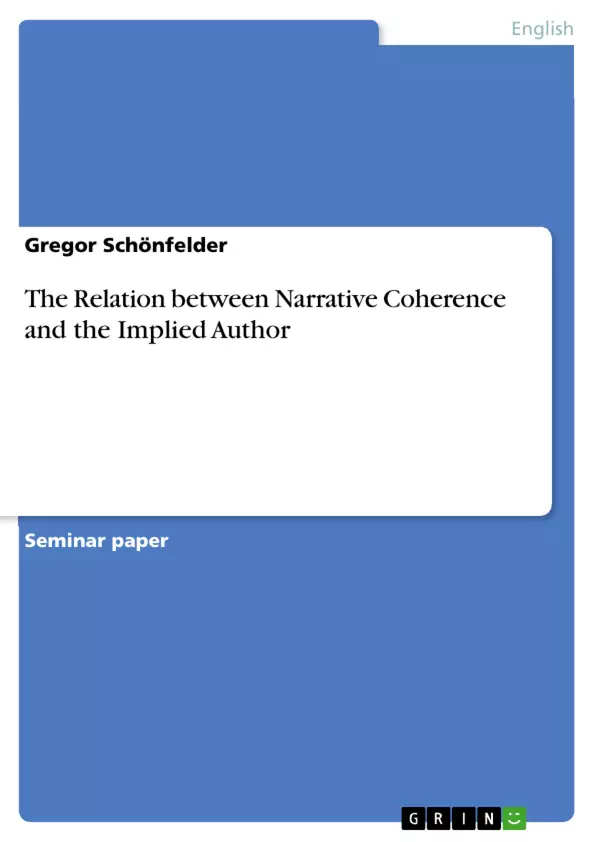For a long time the only accepted form of writing, working completely alone without help is not the only option for writers anymore. New forms have emerged, actively seeking the collaboration of authors in order to create texts that make use of the new possibilities collaboration grants. Though it has not yet achieved the same level of normality as single-author writing, collaborative writing nonetheless has a wide range of readers. As in all forms of writing, readers always try to find an entity that accounts for the text and guides their interpretation. A concept that tries to help in that process is the implied author. While its usefulness is debateable in one-authored writing, this concept is more interesting in collaborative written works as the number of real authors not necessarily corresponds to an equal number of implied authors. This paper is going to prove that coherence is one of the key determinants for creating the implied author. To reach that goal, two texts, both belonging to the genre of crime fiction, will be compared: first, Elementary, a short story dealing with two writers that fail to kill their agent; second, Murder at the Beau Rivage, a poststructuralist story about a serial murder who actually is a serial murderess. However, as the “implied author” and “coherence” are the basis for this analysis, it is, first of all, crucial to come up with uniform definitions and concepts behind the terms since they are not being used consistently in literary studies. Having established the terms, Murder at the Beaus Rivage will serve as an example of how incoherence can cause different implied authors for a text. Then, in order to prove that collaboratively written texts are not bound to have several implied authors, Elementary will be examined in terms of coherence. Finally, as the reader also plays a role in constructing the implied author, a short outlook will be given on the aspects that may be of interest for further research in that field.
Inhaltsverzeichnis (Table of Contents)
- Introduction
- The Implied Author
- Defining Coherence
- Coherence and Implied Author
- Murder at the Beau Rivage
- Elementary
- Outlook: Role of the Reader in constructing the Implied Author
- Conclusion
Zielsetzung und Themenschwerpunkte (Objectives and Key Themes)
This paper explores the relationship between narrative coherence and the implied author, specifically within the context of collaborative fiction. The goal is to demonstrate that coherence serves as a key determinant in shaping the implied author within collaborative works. The paper analyzes two crime fiction texts: Elementary and Murder at the Beau Rivage, to illustrate how coherence impacts the construction of the implied author.
- The role of the implied author in interpreting collaborative fiction.
- The concept of narrative coherence and its impact on the implied author.
- The influence of genre and historical context on narrative coherence.
- The potential for multiple implied authors in collaborative fiction.
- The reader's role in constructing the implied author.
Zusammenfassung der Kapitel (Chapter Summaries)
- Introduction: This chapter introduces the concept of collaborative fiction and its increasing prevalence. It highlights the challenge of interpreting such works, particularly in identifying the implied author, and outlines the paper's thesis: coherence plays a crucial role in shaping the implied author in collaborative texts.
- The Implied Author: This chapter explores the concept of the implied author, introduced by Wayne Booth. It argues that the implied author is a more reliable guide for interpreting a text than the narrator or the real author. The chapter discusses the ongoing debate surrounding the implied author and its relevance to collaborative fiction, where the relationship between real authors and implied authors becomes more complex.
- Defining Coherence: This chapter examines the concept of narrative coherence, acknowledging the difficulty of defining it clearly. It emphasizes that coherence emerges from the interaction of various narrative elements, such as plot, closure, and genre, and how those elements work together within the specific context of the text.
Schlüsselwörter (Keywords)
This paper focuses on the concepts of narrative coherence, the implied author, and collaborative fiction. It delves into the influence of genre and historical context on coherence, particularly within the genre of crime fiction. The analysis of the short stories "Elementary" and "Murder at the Beau Rivage" illustrates the impact of coherence on the construction of the implied author in collaborative works.
- Quote paper
- Gregor Schönfelder (Author), 2010, The Relation between Narrative Coherence and the Implied Author, Munich, GRIN Verlag, https://www.grin.com/document/203782



